Notes
A Photographer, A Fixer, the New York Times and Child Servitude in Haiti: A Story Gone Haywire, then Simply Gone
On May 20, The New York Times Lens Blog posted a photo story about child slavery/servitude in Haiti, entitled The Ultimate Have-Nots in a Society of Have-Nots.
The piece focused on several children identified as restaveks (from the French “stay with”), orphaned or abandoned children living with Haitian families who often treat them as indentured servants and may abuse them. A twelve-year-old girl, Judeline, was identified in the photos and the story as a restavek living with an English teacher’s family.
The story was built around the powerful photos and account of photographer Vlad Sokhin. It was written by Times investigative reporter Deborah Sontag based on Sokhin’s account. Sontag has written extensively on Haiti, including the plight of restavek children.
Two days after posting the piece, Lens took the unusual action of removing the post, along with its 163 comments. In its place, Lens posted an Editor’s Note, implying that a financial arrangement between Sokhin and the “English teacher”/master compromised the credibility of the story. All traces of the original photo story disappeared from the Internet, including the Lens archive. Cached versions of the web address now redirect to the Editor’s Note. The Note itself can only be accessed from the post’s original url.
The controversy-causing passage from the original Lens Blog post read as follows:
“Working with one of the many Haitian fixers who are vital to foreign journalists seeking to go beneath the surface of that society, Mr. Sokhin found Judeline’s “family,’’ which was willing to give him unlimited access for several days last fall and during his second trip to Haiti in March. The father is an English teacher, and, according to Mr. Sokhin, he believes he is giving Judeline an opportunity in life after her own family abandoned her — not only by providing room and board but by paying for education. Relatively speaking, Mr. Sokhin said, the man sees himself as an enlightened “master’’ who would never strike or abuse the young girl who performs his family’s chores.”
The day after the Lens post appeared, the “English teacher” identified in the post, Lesli Petit-Phar, posted an open letter on another photographer’s Facebook thread. In it, Petit-Phar acknowledged his role as the guardian of Judeline, but professed shock and outrage upon seeing himself portrayed as the slave master of Judeline. He wrote:
After reading Petit-Phar’s Facebook post, I reached out to Sokhin, the Lens Blog, Sontag, and Petit-Phar. The Lens Blog and Sontag declined all official comment except to refer me to the Editor’s Note. Petit-Phar has so far not responded. I had several communications with Sokhin. In the first exchange, prior to removal of the post, he agreed to answer a series of questions under the condition we print his comments in their entirety (full text in the addendum following this post, along with full text of the Lens article). The highlights of our exchange were as follows:
- After visiting the Petionville camp with Petit-Phar, the fixer volunteered he had such a child living with him and invited Sokhin to his home to photograph.
- Sokhin says he observed Judeline’s unequal and degrading treatment but that Petit-Phar didn’t see it that way.
- Another restavek child in the story, Enso, happened to live next door.
- Although Sokhin says he did not tell Sontag that the English teacher and his fixer were one in the same, he asserts that he informed one of the Lens Blog editors via Skype the Friday before publication that the subject of his story was also his fixer.
- Supposedly, it was Petit-Phar’s idea to do the shoot, to use his name and describe him as a teacher, and that it was at Petit-Phar’s request that Sokhin not mention his role as a paid fixer.
Certainly this story, as well as the actions of the different parties, leaves us with many questions. Without trying to sort out the true motives, intentions, or even the veracity of those involved, I see a number of specific as well as more general questions for the photography and media communications communities to consider.
As for specific questions, one has to wonder why Petit-Phar would allow himself to become the subject of a story, especially one with an agenda that does not favor him, when at least part of his livelihood was dependent on providing local support to international photojournalists. Why did the photographer hide the fact that Judeline lived with his fixer’s family? Why was Sontag assigned to write a story based on information she did not gather and fact check herself? And if Sokhin did, in fact, inform Lens of Petit-Phar’s employment as his fixer, why didn’t Lens add the information to the story prior to publishing or simply refuse to publish once Sokhin disclosed his relationship? Whoever made or shared in the decision to conceal Petit-Phar’s occupation, wasn’t it up to Sokhin to clearly identify him when he first submitted the photos to The New York Times? Why did Sokhin, after two trips, one last Fall in which he documented Judeline and Enso and then another in March, not spread his focus to independent families with restaveks rather than continue his focus on his fixer and his neighbor? (The Restavek Freedom Foundation claims that 300,000 Haitian children live as restaveks in host homes.)
The reaction of the Lens Blog to Petit-Phar’s public message also spawns many questions for me. What is The Times’ policy for removing a post? How often has this been done in the past? What went into the decision process to take down the post vs. publish a correction, an elaboration or a follow-up story? In removing the story, what consideration, if any, did The Times give to the 163 comments readers contributed to the story? Given how many of those comments exhibited outrage toward Petit-Phar as well as to Haitian society’s treatment of their young in general, does The Times bear more responsibility for the story, and the engendering of those sentiments, than they admit by pointing a finger at Sokhin in their Editor’s Note?
And a more general editorial question: Given how little media and photo coverage there is about Haiti, especially after the depiction of the U.S. as rescuers of the hapless Haitians after their devastating earthquake, is there and should there have been a higher bar to meet in terms of this story? Wasn’t the post at risk of reinforcing the racist stereotype of the Haitians as amoral, lazy and enforcing their own plantation mentality?
I’m also curious why photo blogs, especially those run by major media organizations, don’t fact check photos. It’s not like these images of Judeline, including the one with Petit-Phar, were being published here for the first time. Not only did the photos earn Sokhin an award from Nikon, to name just one appearance (and perhaps another failure to fact check), but several of the photos previously appeared in an article in the NYT’s own International Herald Tribune in December 2012.
Given this controversy and others this year, it must be clear by now that the reach and immediacy of the internet and social media necessitate stricter practices surrounding representation of subjects and subject matter. Did Sokhin and Lens (if they indeed knew the facts prior to publication) think that Petit-Phar, a resident in a developing county, wouldn’t see the story? Ten years ago, that might have been the case, but today internet access reaches all corners of the globe.
Finally, a comment about the word “slavery” as a heavily-loaded semantic variable, one that might have helped blow up the story. (Certainly, Petit-Phar wasn’t taking issue with being designated a “slave owner” out of thin air). If you examine the “restavek” section on Sokhin’s website or the Nikon award entry, his original captions refer overtly to “human slavery.” As for the Lens piece, although the tone and intimation throughout Sontag’s piece treads that territory (she cites the term several times in direct reference to Sokhin’s project and research), the rest of the article and captions are limited to the use of terms like “have nots” or “child laborers” as opposed to “slaves.” A case in point is this revised NYT caption:
As compared to Sokhin’s original from his website:
Why is this important? Well, it’s a lot safer to use these terms rather than directly identify a person as a “slave owner.” In watering down the language, the definition of what these children are and what constitutes their mistreatment becomes more ambiguous even as racially loaded language is avoided. But given the semantic acrobatics, what kind of justice did the story do to the photos, and the supposedly emblematic and extreme treatment of Judeline? Is it possible that the ethical and editorial compromises that ultimately invalidated the story were not obvious until too late? Was it credible to use Judeline as a textbook example of repression and human slavery even before we knew of the financial arrangement between photographer and fixer? Others, I’m sure, are much better equipped to address many of the questions above. We at BagNews are mostly interested in these latter questions as they affect the cultural, racial and economic translations involved in training the lens and the cultural norms of the American media market on ethical behavior in a country like Haiti.
As I see it, there are two main problems with the photos. One is the degree of repression, even trauma, attributed to the images with the descriptive text. The second has to do with how much Judeline becomes the representative example of the exploited Haitian servant, or child slave, even though her situation is not nearly as exploitative or extreme as that of other children depicted in the Lens slideshow.
Sontag focuses on two images in the original Lens post: the lead photo of Judeline serving Petit-Phar a beer and a second photo of Judeline with Petit-Phar’s daughter, Boubou. Regarding the former, Sontag’s description states that:
(Judeline) stands frozen holding a tray, her eyes on the father, whose gaze is cloaked by sunglasses but appears to be fixated on the cold beer she is offering him.
When Sontag uses the term “frozen,” the implication, to me at least, is “frozen with fear.” Significant as it is in the one photo placing Petit-Phar and Judeline together, I can see subservience but I’m not sure I’m seeing fear here. In fact, it seems as easy to observe how forthrightly Judeline takes in Petit-Phar when a servant would typically look away. Certainly, it doesn’t engender the same kind of chill I get from at least two other photos from the slideshow, including this shot of restavek Jeanse and her “host.”
The caption with the photo reads:
Jeanse stays close to one of her hosts. She does not have any identification documents and is not allowed to go to school.
Here, I see a raw, brazen look from what really feels like a master, her leg amputated with the stump jutting out and the other side of her skirt pulled up, her eyes wary and her mouth set, Jeanse touching her and her wheelchair with her arm but her leg angled away, her expression as emotionally dissociated as one can be.
Nor does the Judeline/Petit-Phar beer photo cause me the same level of concern as the photo of Etienne and his “host,” Ivene.
The photo is captioned as follows:
Etienne, 11, lives with Ivene, 32, a grocery and liquor store owner in Port-au-Prince. Etienne works long hours in the shop and, like many restaveks, is subject to abuse.
I believe this is the photo, referenced near the end of the Lens article, in which the “owner” then sticks the cigarette in the boy’s mouth. Here is the tension and anxiety missing from the Judeline images, Ivene’s breezy, if amoral grin paired with Etienne’s plaintive eyes.
Sontag opens the article with a description of the Judeline/Boubou make-up photo:
Twelve-year-old Judeline crouches at the feet of a much younger girl, lifting high a makeup kit so the little girl, Boubou, can apply a colored pencil to her brow. Boubou studies herself intently in the kit’s mirror; Judeline, hidden to her, stares at us with a look that seems both humiliated and beseeching. Taken by the photographer Vlad Sokhin for a series called “Restavek: Child Slavery in Haiti,’’ it is one of the most haunting images … of a Haitian servant child that I have ever seen.
I have no way of interpreting the expression on Judeline’s face. I’m willing to believe, however, that she is shamed when Boubou asserts authority over her. Still though, Sokhin, in a follow-up communication, stated to me that the two girls play together at other times. He claimed that once Boubou saw Sokhin photographing Judeline, she wanted to put on make-up for her photo. If this instance is humiliating, the little girl pulling rank out of jealousy, does it qualify as that “most haunting”?
Is it as humiliating and as haunting as the photo in the slideshow of “one of the members of Enso’s host family dissatisfied with his work?”
Or as humiliating as the photo of Enso which informs us he “sleeps on rags on the floor of the storage room?”
There is still another factor in the analysis of these photos: the photos are from two different trips (a week in October 2012, and then two weeks in March 2013). You can tell by Judeline’s hair, close cropped in some photos, longer and braided in others. Petit-Phar mentions in his Facebook comment that, between the two shoots, the family hired a maid. This was confirmed by Sokhin in his communication with me. Given how prominently the photo of the longer-haired Judeline sweeping is featured in the story (a photo, to my mind, that feels a little listless somehow), it’s that much harder to see the picture as damning — unless the point of the photo is sadism, the “slave owners” forcing Judeline to keep pushing after more help came on board.
And that goes to the heart of the problem with the original Lens post. Many of the photos of Judeline feel unnatural, posed, as if they are seducing us to outrage. They don’t necessarily feel fearful, dangerous, or abusive. If, in this way, they reflect the photographer’s inordinate access (and the sense that the subjects have been contracted to play their roles), no one would know that’s what Sokhin purchased. At the same time, however, the photos just don’t feel right: they are too affected and self-conscious, especially observed side-by-side with the photos and portraits of the other “slaves.” And isn’t it that oddity, that distinction, we expect the trained eyes at Lens to ferret out? Not to go the opposite way and bring in an investigative journalist with a track record in exposing the subjugation of these children to hold forth about how the photos seal the conviction.
To the degree that children are victims here, it’s Enso (and Jeanse and Etienne) whose photos display greater pain — but it’s their depictions that are sublimated to the prettier but less dire photos of Judeline. And it’s the photos of Judeline, compromised as they are, that seem anxious to relate an agenda. There is a maxim my father used to tell about the man who keeps looking for his quarter not where he dropped it but much further away, where the street lamp is shining. Whether Sokhin is guilty of manipulating his fixer for this degree of access to Judeline, or the two men were using each other, the problem here, strictly from a visual standpoint, is that Lens failed to appreciate how little the access bought.
(written with Karen Donley. photos: Vlad Sokhin/Agentur Focus)
ADDENDUMS to post include: full text of NYT Lens story; Captions and links to all slideshow photos — still available on NYT server at time of this writing; and written answers by photographer Vlad Sokhin to email questions.
———
Addendum 1: Full Text of NYT Lens Story
The Ultimate Have-Nots in a Society of Have-Nots
(slideshow)
Twelve-year-old Judeline crouches at the feet of a much younger girl, lifting high a makeup kit so the little girl, Boubou, can apply a colored pencil to her brow. Boubou studies herself intently in the kit’s mirror; Judeline, hidden to her, stares at us with a look that seems both humiliated and beseeching.
Taken by the photographer Vlad Sokhin for a series called “Restavek: Child Slavery in Haiti,’’ it is one of the most haunting images (Slide 4) of a Haitian servant child that I have ever seen.
Judeline’s hair is close-cropped, boyish. Boubou, the 5-year-old daughter of the family for whom Judeline works, is beribboned. Boubou has natural, apparent self-regard; Judeline, her bra strap slipping down her thin arm, has learned to be self-effacing to survive.
It is not easy to photograph people who are invisible in their own society, to shine a light on them and at the same time reveal how unseen they are to those around them.
That is the strength of what Mr. Sokhin does, perhaps partly because he approached the subject with the outrage of a fresh eye. Born in Russia and educated in Lisbon, he now lives in Sydney, Australia, and had never set foot in the Americas, much less in Haiti, until last year.
He visited New York last fall to take part in the Eddie Adams Workshop for photojournalists and in a group exhibition. With a few free weeks between the two events, he said in a phone interview from Australia, “I thought I’d just go to Haiti and see what’s there.”
While preparing for his trip, Mr. Sokhin, who is drawn to post-disaster and post-conflict societies, happened upon the memoir of a former child servant, Jean-Robert Cadet, who is Haiti’s best-known restavek “abolitionist.” Mr. Sokhin was struck by his story. He had never heard of the restavek phenomenon, he said, and to discover that, in the 21st century, a nation born of a slave revolt was “using its own children as slaves was ridiculous to me.’’
(inline photo)
Vlad Sokhin/Agentur Focus
John, 40, with his restavek, Mamaika, 8, who has been living with him since the 2010 earthquake.
International advocates for children estimate that there are 250,000 restaveks in Haiti — children working as unpaid domestic servants after their parents, who cannot afford to raise them, give them away.
The literal translation of “restavek” is relatively benign: these children, mostly girls, are “live-ins” or “stay-withs.’’ But the social translation is brutal. To be a restavek is to be the ultimate have-not in a society of have-nots; the word itself is a slur.
In 1990, I wrote a long story on the restaveks for The Miami Herald’s Sunday magazine. This was before any child advocacy organization had taken up their plight, before groups like the Restavek Freedom Foundationwere working to defend, protect and educate them. The phenomenon was everywhere — scruffy, scrawny children rising before dawn to empty chamber pots, bedding down at night on piles of rags, enduring beatings and sexual assault — but it was rarely discussed.
Still, many Haitians found it shameful. And amid the relative idealism of that period, not long after the despotic “President for Life” Jean-Claude Duvalier had fled into exile, it seemed possible that the practice would be relegated to the ash bin of history along with other egregious abuses.
How dispiriting, then, to gaze into the eyes of Mr. Sokhin’s subject Judeline and see the present-day reflection of the sad-eyed 12-year-old restavek named Judith whose painful situation I documented so long ago.
While much has been written about restaveks in the decades since, Mr. Sokhin said he found little “visual evidence” of the phenomenon. In many photographs, restaveks were indistinguishable from other poor children — they were dressed raggedly, looked malnourished and lugged water in buckets bigger than themselves.
To document their plight freshly, it was crucial to show them in context, inside the homes where they lived and worked.
Working with one of the many Haitian fixers who are vital to foreign journalists seeking to go beneath the surface of that society, Mr. Sokhin found Judeline’s “family,’’ which was willing to give him unlimited access for several days last fall and during his second trip to Haiti in March.
The father is an English teacher, and, according to Mr. Sokhin, he believes he is giving Judeline an opportunity in life after her own family abandoned her — not only by providing room and board but by paying for education. Relatively speaking, Mr. Sokhin said, the man sees himself as an enlightened “master’’ who would never strike or abuse the young girl who performs his family’s chores.
(inline photo)
Vlad Sokhin/Agentur Focus
Jeanse stays close to one of her hosts. She does not have any identification documents and is not allowed to go to school.
That Judeline slept on the hard floor of an unfurnished room was portrayed as her personal choice: “They say she doesn’t like to sleep on a bed,’’ Mr. Sokhin said. The family made the same case for her use of the yard as her bathroom.
In addition to the photograph where Judeline is playing personal attendant to little Boubou, Mr. Sokhin caught several other moments in which family members disregarded her while she served them.
In one photograph, she stands frozen holding a tray, her eyes on the father, whose gaze is cloaked by sunglasses but appears to be fixated on the cold beer she is offering him (Slide 6). In another, she is washing the mother’s hair and the mother, reclining and chewing gum, is blowing a big, pink bubble (Slide 2).
Mr. Sokhin said he tried not to include in his series any pictures that Judeline herself might find degrading. “I have got much worse pictures,” he said, “but I didn’t want to show her suffering.”
Sometimes he was forced to put down his camera so he would not be participating in mistreatment, he said. In one photograph (Slide 20), a man who refused to have his identity revealed nonetheless slung his arm around the shirtless shoulders of his restavek boy while Mr. Sokhin was shooting. His head is cut off, a lit cigarette dangles from his hand, and the effect is creepy.
Even creepier, Mr. Sokhin said, was what he declined to photograph next: the man put the cigarette in the little boy’s mouth, laughing.
Another time, a woman was unhappy with how a 9-year-old restavek, Enso, was making her bed. Mr. Sokhin took a few pictures as she started to push the boy around (Slide 10), but put his camera down and intervened when she began beating him, he said.
“A few photographers from the States who have seen these pictures, they have approached me and told me it’s very important to cover this,’’ Mr. Sokhin said. “So I’m not sure if this project is actually finished.’’
(inline photo)
Vlad Sokhin/Agentur Focus
All of Judeline’s earthly possessions fit into two boxes.
Follow @Vlad_Sokhin and @nytimesphoto on Twitter. Lens is also onFacebook.
Showcase, Child labor, Children, Deborah Sontag, Haiti, Have-nots, Indentured servitude,Jean-Robert Cadet, Port-au-Prince, Post-conflict photography, Restavek, Restavek Freedom Foundation, Slavery, Vlad Sokhin
163 Comments
———
Addendum 2: Captions and links to all slideshow photos — still available on NYT server at time of this writing.
Judeline, 12, left, a child laborer for the family of an English teacher, swept the floor while her host, Geshly, 34, checked messages on a cellphone. Some women in Haiti ask their husbands to find restavek children to do the household chores.
Judeline washed Geshly’s hair. She must stay within hearing range of her hosts in case they have orders.
Judeline in her room.
Boubou, 5, put on makeup as Judeline held her kit up for her.
Judeline brought in water from a well. She goes to school every morning but can only do her homework after she finishes all the chores at her host family’s home. She isn’t allowed at the table and studies on the stairs of the house.
Judeline served a beer to Lesli, 34, an English teacher in Port-au-Prince. She has been living with Lesli’s family since 2009.
Kids played on and around abandoned cars in a junk yard in Port-au-Prince. After the 2010 earthquake, many children were left homeless or orphaned, and many became domestic workers.
Enso, 10, was found by his host family on the street when he was a year old. He began working for them when he was 2 and now does all the chores in a household of six.
Enso making the bed. He works all day, sleeps on the floor and is not allowed to play with other children or go to school.
One of the members of Enso’s host family was dissatisfied with his work.
Enso sleeps on rags on the floor of the storage room. He is not allowed to have his own bed and pillow.
Olrtega, 13, grabbed a bite from the plate of his hosts while they weren’t home. He became a restavek in 2008, when his mother gave him away. He is forbidden to have meals at the table with his host family.
Jeanse, 16, has been a restavek for six months in the house of a woman who took her from a refugee camp in Pétionville. She spends her days doing household chores, is subject to physical and verbal abuse and is not allowed to go to school.
Givnin, left, played with her friends in a slum in Port-au-Prince. It was her last year in her birthplace with family and friends. Unable to provide enough food for all her children, Givnin’s mother was going to give her daughter to a host family.
Mamose, 12, stood by a drawing of her future house and family. She is in seventh grade; her education is paid for by the nonprofit Restavek Freedom Foundation.
A classroom in a Port-au-Prince primary school. The Restavek Freedom Foundation provides free education to these children, who still live with host families and go back to their chores each day after school.
A boy reflected in the mirror of a street hairdresser in a slum.
Viviane, 11, left, helped her sister, Islande, 13, clean dishes in their host family’s house. The sisters have lived in servitude since 2008, when their mother gave them away.
Lilyo, 10, a former restavek and an orphan, escaped from his host family in 2011. He sleeps in abandoned buildings with other street kids and makes his living by washing cars. He said he preferred a dangerous but free life to servitude.
Etienne, 11, lives with Ivene, 32, a grocery and liquor store owner in Port-au-Prince. Etienne works long hours in the shop and, like many restaveks, is subject to abuse.
———
Addendum 3: written answers by photographer Vlad Sokhin to email questions.
1. How do you respond to Lesli’s allegations; are they false, true or is there more information you can provide us in writing that explain the different depictions of the situation?
Before going to Haiti I sent Lesli a series of emails explaining that I wanted to contract him as my fixer. My emails outlined what I wanted to achieve.
My emails show that I did not tell Leslie that my project was to show that all children who live with a family are not treated as slaves.
I said “I’m going to be working in Port-au-Prince on a photo-story about restaveks. I’m looking now for the families who have restaveks in their homes”.
In a second email I said “…I need that those families that we are going to visit will be agree if I photograph them“.
A third email said: “Also I would ask you to find real families. Unfortunately I’ve been working couple of times with not honest fixers, who staged things for me, finding fake people just to get money. I’m sure that you are not one of them and hope our collaboration will continue in future.”
At lunch time on our first day of working together after taking me to one of the camps Lesli told me he had a restavek child living at his house. He then invited me to come to his house and take photographs. I was surprised that Lesli had a restavek child and that he wanted to show me how she lived.
Lesli says that Judeline is treated as part of the family and does not do a lot of household chores. I do not believe this is true.
I asked Judeline where she slept and she said on the floor. I asked Lesli why and he said she liked to sleep on the floor. Judeline went to the back yard to go to the toilet. She was not allowed to use the toilet or bath in the house.
The first day I visited Judeline I stayed for half a day. In this time she was cooking, setting the table and serving food, cleaning the house, fetching water. The only rest she took was to do her homework on the stairs, I’ve got an impression that she was not allowed to sit at the table inside the house.
2. Are you aware that Judeline’s mother asked Leslie to care for her?
Lesli told me that Judeline’s mother gave her up.
3. Most importantly, was Lesli your fixer and or did you pay him for the services provided by a fixer. Did he indeed locate Enso for you?
I contracted Lesli as a fixer, without knowing that he had a restavek child living in his home. I paid him at the rate he has indicated. He took me to one of the camp and promised to find some families with restavek children. Instead of this he took me to his house.
While I was taking photos at Lesli’s house, Enso entered Leslie’s back yard to hang washing on the line. Lesli explained he was a restavek child who lived next door. I asked if it would be possible to photograph Enso as well. Lesli asked the neighbours, who gave permission.
Before leaving Haiti I asked Leslie whether I could visit him again to follow up Judeline’s and Enso’s stories when I next visited Haiti. He agreed, but said I would have to pay him for his time, which I did in March 2013 when I came to Haiti again.
4. If Lesli was your fixer, what is your opinion of turning around and using a fixer as a story subject?
I did not instigate photographing Lesli’s family. I did not even know he had a restavek child living in his home when I commissioned him.
Lesli instigated the shoot. He agreed to me using his name and occupation as a teacher, but asked me not to mention that he was also a fixer. He did not seem ashamed of having the child, as he referred to this many times as being part of Haitian culture. My impression was that he did not want other international photographers who work in Haiti to know that he had a restavek child living in his house. Since the story was published, I have been in contact with other photographer based in Haiti who said he double checked and confirmed that Leslie did have a restavek child living in his home. The photographer said he “won’t be recommending any journalist to work with him”, which suggests Lesli’s concerns were well founded.
5. Was Lesli aware that you were using him as a story subject and you were photographing Judeline as a restavek or exploited child?
Lesli was informed about the specific nature of my project and gave me approval to take photographs of his family and the restavek child living in his home.
He refers to Judeline as a restavek.
6. If Lesli was your fixer or paid him for assistance for the story and locating restavek children, was anyone at the NYT Lens Blog aware of that fact?
Having given my word to Lesli that I would not make public that he was a fixer, I did not discuss this with the journalist. However, I spoke to an editor at the NYT lens blog on skype couple of days before publication (Friday afternoon NY time) and mentioned that Lesli was one of my fixers.
After the story was published on Lens blog, I gave a call to Lesli and informed him that some of the images of him and his family were published in NYT and that I didn’t say that he was my fixer as he asked me. Lesli confirmed once again that it’s ok with him.
I didn’t made this story, it’s all true. I also understand that Lesli does not see Judeline’s suffering. This is the reality for restavek children in Haiti. Their needs are unseen by the families that they live with. They do not have the same childhood as the other children in the families they serve. Had Judeline’s story not been so relevant to my mission, I would not have chosen to photograph a fixer and his family. However, after seeing how Judeline lived, I wanted to show the reality of her life.
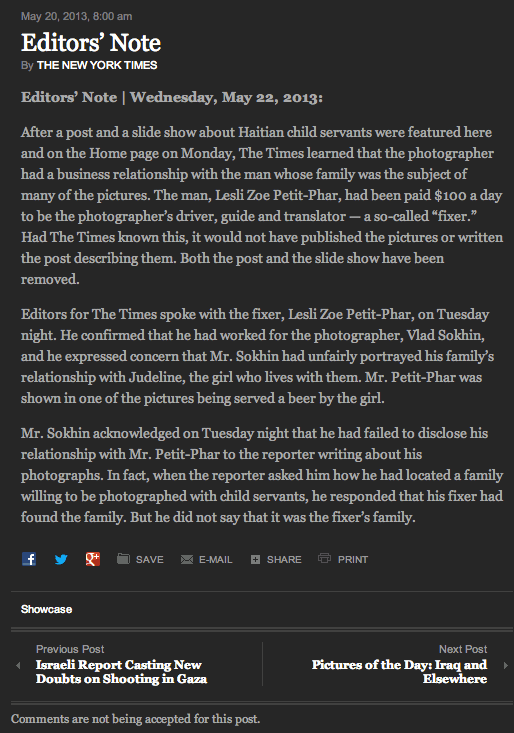
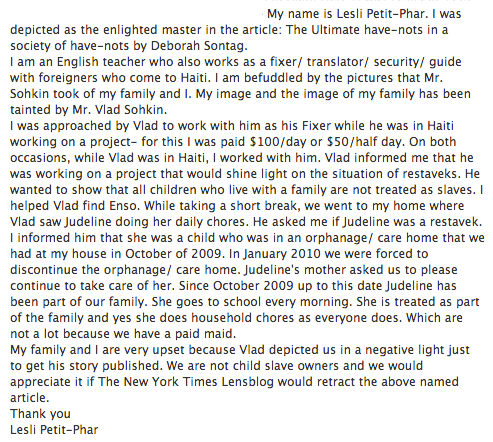
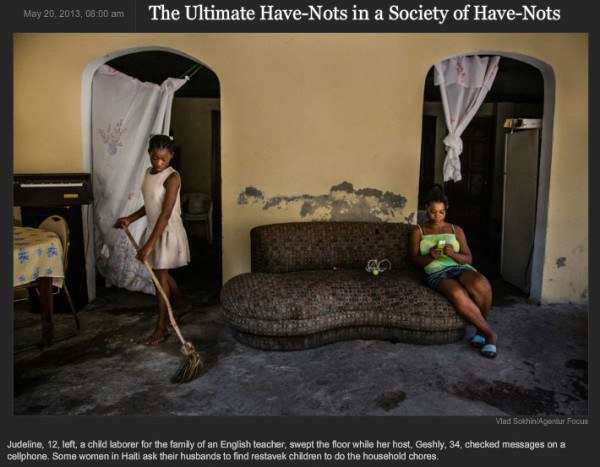
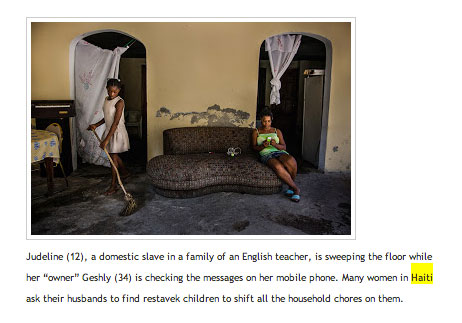
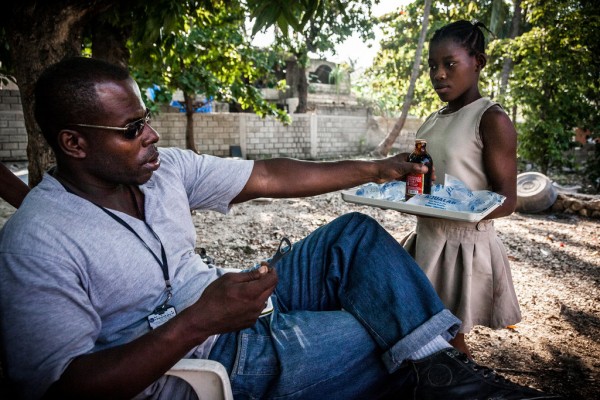
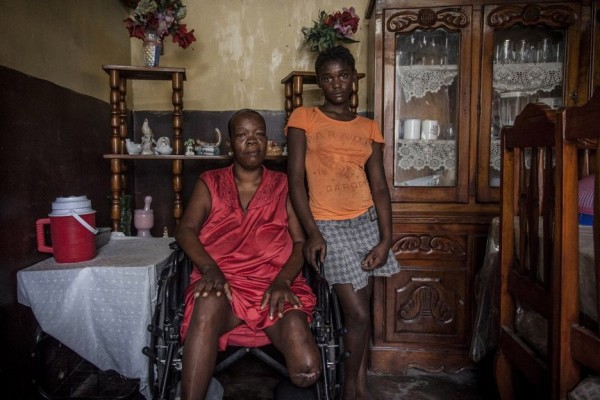
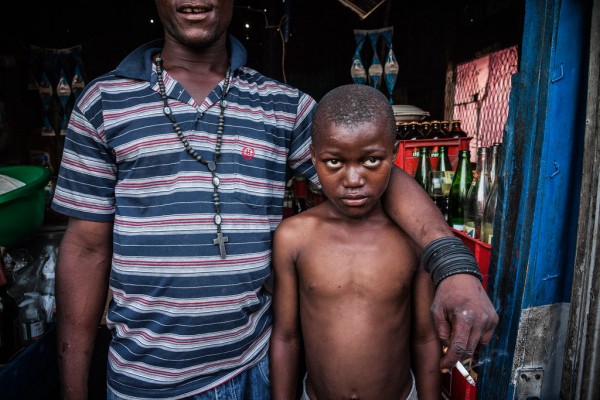
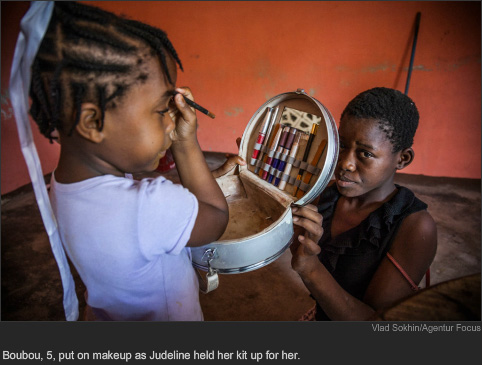
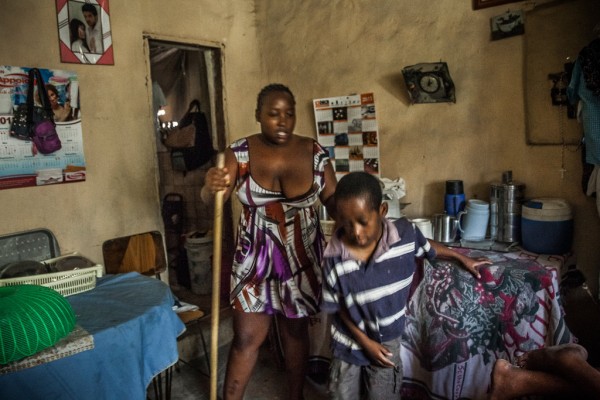
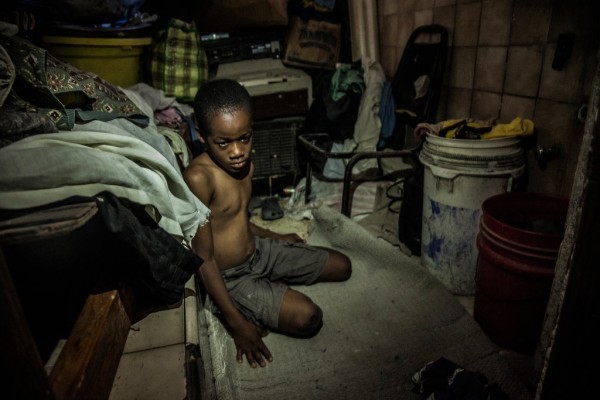
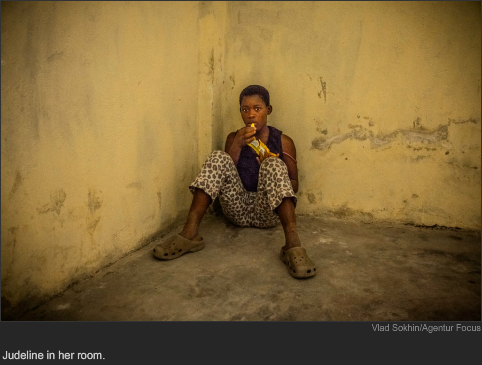
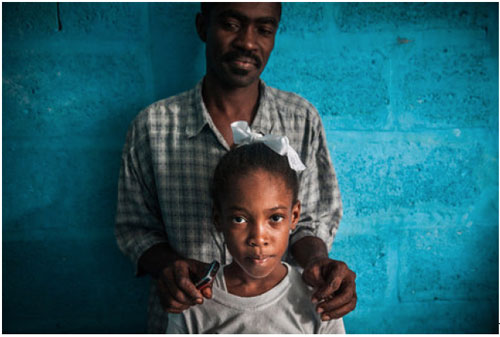
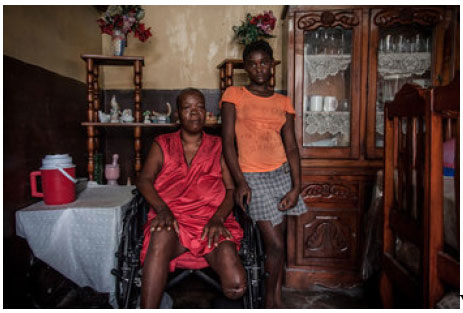
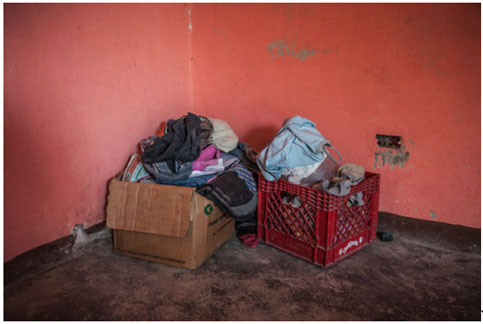
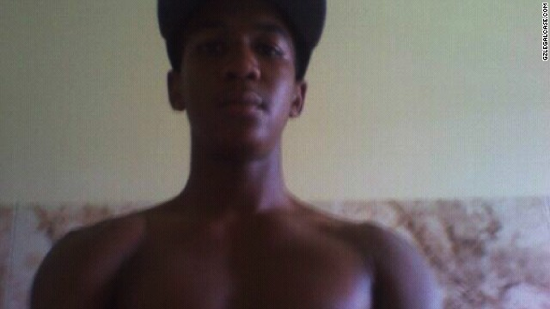
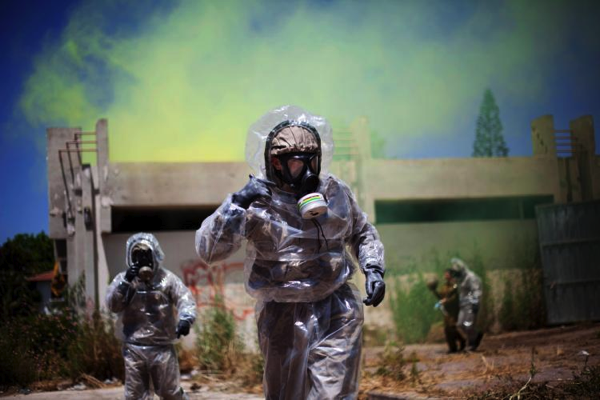
Reactions
Comments Powered by Disqus